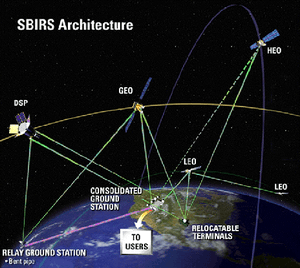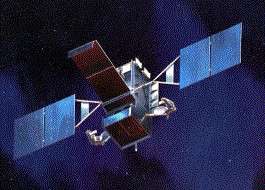Space-Based Infrared System

The Space-Based Infrared System (SBIRS) is a consolidated system intended to meet the United States' infrared space surveillance needs through the first two to three decades of the 21st century. The SBIRS program is designed to provide key capabilities in the areas of missile warning, missile defense and battlespace characterization.
SBIRS is an integrated "system of systems" that will include satellites in geosynchronous orbit (GEO), sensors hosted on satellites in highly elliptical orbit (HEO), and ground-based data processing and control. A complement of satellites in low earth orbit was planned as part of the program (SBIRS Low), but this has been moved into the STSS program. SBIRS ground software integrates infrared sensor programs of the U.S. Air Force (USAF) with new IR sensors. SBIRS continues to struggle with cost overruns,[1] with Nunn-McCurdy breaches occurring in 2001 and 2005. By September 2007, the expected project cost had increased to $10.4 billion.[2][3]
The original contract consisted of 2 HEO satellite sensors and 2-3 GEO sensors (and satellites) with an option to buy a total of 5 GEOs. In December 2005, following the third SBIRS Nunn-McCurdy violation, the government decided to compete GEO 4 and 5, with an option to buy the GEO 3 contingent based on the performance of the first two. Additionally, the government started a potential SBIRS High replacement program, writing out proposals in June 2006.
On June 2, 2009 Lockheed Martin announced it had been awarded a contract for the third HEO payload and the third GEO satellite, and for associated ground equipment modifications.[4] On July 10, 2009, Lockheed Martin was awarded $262.5 million as down payment by the USAF towards the purchase of a fourth satellite.[5] The first GEO satellite of the SBIRS program, GEO-1, was successfully launched from Cape Canaveral on an Atlas V rocket on May 7, 2011.[6]
In summary, as of January 2017, a total of nine satellites carrying SBIRS or STSS payloads had been launched: GEO-1 (USA-230, 2011), GEO-2 (USA-241, 2013), GEO-3 (USA-273, 2017), HEO-1 (USA-184, 2006), HEO-2 (USA-200, 2008), HEO-3 (USA-259, 2014), STSS-ATRR (USA-205, 2009), STSS Demo 1 (USA-208, 2009) and STSS Demo 2 (USA-209, 2009). In June 2014, Lockheed Martin was contracted by the USAF to build GEO-5 and GEO-6, at a cost of $1.86 billion.
Background
Based on its experiences with the launching of short-range theater missiles by Iraq during the 1991 Persian Gulf War, the U.S. Department of Defense (DOD) concluded that expanded theater missile warning capabilities were needed, and it began planning for an improved infrared satellite sensor capability that would support both long-range strategic and short-range theater ballistic missile warning and defense operations. In 1994, DOD studied consolidating various infrared space requirements, such as for ballistic missile warning and defense, technical intelligence, and battlespace characterization, and it selected SBIRS to replace and enhance the capabilities provided by the Defense Support Program (DSP). The Defense Support Program is a strategic surveillance and early warning satellite system with an infrared capability to detect long-range ballistic missile launches, and has been operational for over 30 years. DOD has previously attempted to replace the Defense Support Program with:
- the Advanced Warning System in the early 1980s
- the Boost Surveillance and Tracking System in the late 1980s
- the Follow-on Early Warning System in the early 1990s
According to the Government Accountability Office (GAO), these attempts failed due to immature technology, high cost, and affordability issues. SBIRS is to use more sophisticated infrared technologies than the DSP to enhance the detection of strategic and theater ballistic missile launches and the performance of the missile-tracking function.
SBIRS High

SBIRS High (also now simply referred to as "SBIRS") is to consist of four dedicated satellites operating in geosynchronous earth orbit, and sensors on two host satellites operating in a highly elliptical orbit. SBIRS High will replace the Defense Support Program satellites and is intended primarily to provide enhanced strategic and theater ballistic missile warning capabilities. SBIRS High GEO 1 was launched on May 7, 2011.[7] Two SBIRS sensors hosted on two classified satellites in highly elliptical orbit have already been launched,[8] probably as part of the NROL-22 (USA 184) and NROL-28 (USA 200) launches in 2006 and 2008.[9][10] USA 184 and USA 200 are believed by analysts to be ELINT satellites in the family of JUMPSEAT and TRUMPET; TRUMPET has been reported to have carried an infrared sensor called HERITAGE.
The prime contractor for SBIRS is Lockheed Martin, with Northrop Grumman as the major subcontractor. Lockheed Martin also provides the satellite for SBIRS GEO. The system's expected deployment was delayed from December 2009 to 2011 because of problems with Lockheed's workmanship on system components, including unresolved software malfunctions and several broken solder joints in a subcontract procured gyroscope assembly on the first spacecraft being built.[11]
It was feared that a further launch postponement into late 2011 would lead to conflict with the planned launches of NASA's Juno spacecraft and Mars Science Laboratory, which will all use the same launch facility.[12] However, the first GEO launch, GEO-1, was successfully conducted on May 7, 2011.[6]
According to a Reuters report, the first two SBIRS GEO satellites started operations in 2013.[13] GEO-3 launched on 20 January 2017.[14]
SBIRS Low (Space Tracking and Surveillance System)

The SBIRS Low contract is now managed by the Missile Defense Agency (MDA) and has been subsequently renamed to the Space Tracking and Surveillance System (STSS).
Original SBIRS Low
The SBIRS Low program was originally expected to consist of about 24 satellites in low earth orbit. The primary purpose of SBIRS Low was the tracking of ballistic missiles and discriminating between the warheads and other objects, such as decoys, that separate from the missile bodies throughout the middle portion of their flights. The system was to have two major sensors, coordinated by an on-board computer:
- a scanning infrared sensor, designed to acquire ballistic missiles in the early stages of flight.
- a tracking infrared sensor, designed to follow missiles, warheads, and other objects such as debris and decoys during the middle and later stages of flight. The tracking sensor would be cooled to very low temperatures.
SBIRS Low's original deployment schedule was 2010, the date when its capabilities were said to be needed by the National Missile Defense System.
Space Tracking and Surveillance System
In 2001, the Missile Defense Agency assessed the programs needed for a national ballistic missile defense system (BMDS) and found that they were lacking in the relatively new arena of space. The MDA decided to absorb the SBIRS Low constellation in its very early stages of development and renamed the program the Space Tracking and Surveillance System (STSS). This transition changed the direction of the program somewhat, but the overall mission remained the same—detection and tracking of ballistic missiles through all of its phases of flight.
References
- ↑ "INTELLIGENCE AUTHORIZATION ACT FOR FISCAL YEAR 2000: Space-Based Infrared System-High (House Report 106-130)". U.S. Government Printing Office. 7 May 1999.
- ↑ "Space Based Infrared System High Program and its Alternative (GAO-07-1088R)". Government Accountability Office. 12 September 2007.
- ↑ CDI: Fact Sheet on Space Based Infrared System
- ↑ "U.S. Air Force Awards Lockheed Martin $1.5-Billion Contract For SBIRS Follow-On Spacecraft". LM. June 2, 2009.
- ↑ Vorman, Julie (July 10, 2009). "Lockheed gets $262.5 million U.S. satellite down payment". Reuters.
- 1 2 United Launch Alliance report
- ↑ "Rocket blasts off with missile-warning satellite". Reuters. 7 May 2011.
- ↑ "U.S. Air Force Awards Lockheed Martin $1.5-Billion Contract For SBIRS Follow-On Spacecraft".
- ↑ "Molczan in Satobs message 30 September 2005".
- ↑ "Molczan in Satobs message 24 February 2008".
- ↑ Capaccio, Tony, "Delivery Delayed For Lockheed Martin's Early Warning Satellite", Bloomberg.com, Sep 30, 2009.
- ↑ Thompson, Loren B. Launch Priority: Missile Warning Has To Come First Lexington Institute, 22 October 2010
- ↑ "Lockheed wins $1.9 billion deal for U.S. missile-warning satellites". Reuters. Jun 25, 2014.
- ↑ GEO-3 launched
External links
- Space-Based Infrared System Low at Risk of Missing Initial Deployment Date, U.S. General Accounting Office, Feb. 2001.
- Fact Sheets : Space Based Infrared Systems : Space Based Infrared Systems
- Tactical Ballistic Missile Warning, US Strategic Command

